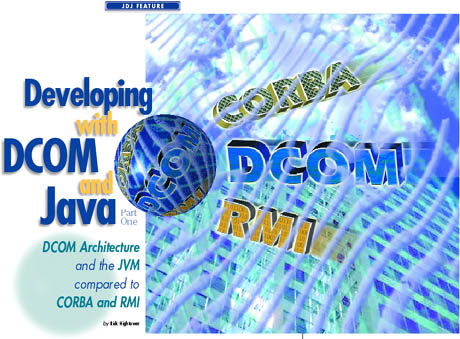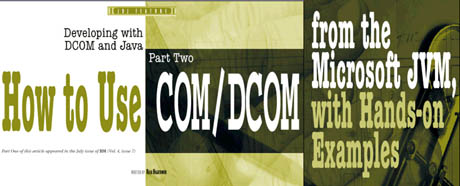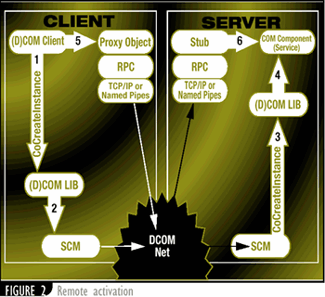
The following page highlights some articles that I have written.
It gives an excerpt from each article and provides links to the articles.
Hopefully, you will get a glimpse and check each one out.
Series on Scripting Languages for the JVM
Series on Java DCOMJava DCOM, CORBA and RMI Java DCOM examples

"The Component Object Model provides a means to create extensible services called components. As components mature (evolve) and add new features and functions, the services they provide remain backward-compatible with older incarnations of the components they replace. This enables older applications (COM clients) to treat new components like older components. Thus, when you upgrade the component, older client applications continue working.
...
In this article we covered:...
- How DCOM compares to RMI and CORBA
- Why DCOM may be important to you
- What DCOM architecture looks like
- How to use the Microsoft Java SDK to create DCOM objects
...
In the book Java Distributed Objects by Bill McCarty and Luke Cassady-Dorion (Sam Publishing), the subject of DCOM is covered in more depth. The book also covers RMI and CORBA in detail (with an emphasis on CORBA). I wrote Chapter 20 on DCOM, which covers Java and DCOM in more detail and relates how to create callbacks in DCOM and how to use JActiveX to create Java wrappers around existing COM components. I also have an example that uses late bound calls using IDispatch."About the Author
Rick Hightower, a senior software engineer at LookSmart, a category based Web directory, has been writing software for a decade, from embedded systems to factory automation solutions. Rick recently worked at Intel's Enterprise Architecture Lab, where he researched emerging middleware and component technologies. Rick can be reached at Rick_M_Hightower@hotmail.com.

"How can Java classes be used as scriptable components? DCOM, like CORBA, provides both static and dynamic invocation of objects. DCOM uses type library to provide metadata to do the dynamic invocation and introspection similar to CORBA's interface repository or Java's introspection mechanism.IDispatch, a standard COM interface that supports Automation (late binding), is great for scripting languages such as Perl, Python, VBScript, JScript and so on. The Microsoft JVM implements IDispatch automatically for all Java objects. Microsoft refers to this feature as AutoIDispatch. Before AutoIDispatch, Java programmers had to write their own IDL files. Now all we have to do is create a Java class. Any public methods or member variables are automatically exposed via Automation. Anything that makes my job easier, I like.
Java programmers don't need to create interface definition files (IDL/ODL) to create COM objects. In addition, special tools like IDL compilers aren't necessary when doing Java COM development.
To implement a COM object in Java using AutoIDispatch, follow these steps:
1. Write a Java class and compile it. The class must have public members and methods.
2. Register the class using JavaReg.
...
...
Conclusion
You know how to create a local COM server and a remote COM server. You know how to test both a local and a remote COM server with OLEVIEW. You know how to configure a COM server to be a remote server with JavaReg and DCOMCNFG. If you read this article and the previous one, you should have a feel for the difference in the architectures of DCOM, CORBA and RMI."

link"Back before Java became popular, I was a C++ bigot. I programmed in nothing but C++. I lived, ate and breathed C++. If it wasn't C++, it was rubbish. I thought C++ was the alpha and omega of object-oriented programming. I had "operator overloading" for breakfast, "templates" for lunch and "multiple inheritance" for dinner, and I always went back for seconds.Then a funny thing happened. I got a new job at another company as a C++ programmer. But they pulled the old bait and switch. Once I started working, someone suggested writing a good portion of a large project in a scripting language. I protested - I would not condescend to program in any other language but C++.
Shortly after I started at this new company the following edict was put forth: "Thou shall use a scripting language." Thus I was forced by management to write a good portion of the project in a high-level scripting language. They told us to glue components written in C++ together with this scripting language (in addition to writing components in C++). At first I hated it, as any self-respecting C++ bigot would. Then, gradually, the productivity of my team - and me - skyrocketed.
...
...
Components (JavaBeans) and distributed components (CORBA, EJB, RMI) have a symbiotic relationship with high-level languages. For example, Visual Basic did well because of VBX, OCX and ActiveX components. And COM/ ActiveX/DCOM did well because of tools like Visual Basic, PowerBuilder, Delphi, and so on. On the Java platform we have the component models; we need the glue, that is, tools for the high-level languages - such as debuggers and IDEs.Scripting languages are dynamic, interactive environments that help you develop Java code rapidly. The mere assertion that scripting languages improve productivity five to 10 times merits your interest. Go find a scripting language that runs in the JVM and conquer your next Java project in record time. Then let us know how it went.
Author Bio
Rick Hightower currently works at Buzzeo Corporation (www.buzzeo.com), the maker of ZEOLogix, an EJB Application Server, Rules Engine and Workflow. He is a principal software engineer working on an EJB container implementation and distributed event management. In addition, he is author of a book, Programming the Java APIs with JPython, to be published by Addison Wesley Longman.
He can be reached at: rick_m_hightower@hotmail.com."
link"JPython is the 100% Pure Java version of Python and is freely available - source code and all. An extremely dynamic, object-oriented language, JPython is in its second major release - JPython 1.1. Since JPython is the same syntax and language as Python, I'll use the terms interchangeably for the rest of this article....
...This isn't a case of my-language-can-beat-up-your-language syndrome. JPython doesn't replace Java; it augments it. Java and JPython have complementary roles - sometimes they overlap.
...
...Parting Shots
...
...
A recent poll at the NetBean's Web site showed JPython as the leading Java scripting language. In our poll at JDJ, JPython is neck and neck with NetRexx.Components have a symbiotic relationship with high-level languages. For example, Visual Basic did well because of ActiveX components. And ActiveX did well because of tools like Visual Basic. On the Java platform we have the component models; we need the glue, that is, tools for the high-level languages - debuggers, IDEs, and the like. JPython makes good glue, and it transcends the role of a glue language.
For more information on JPython see Guido Van Rossum's article at www.developer.com/journal/techfocus/081798_jpython.html. See also www.jpython.org/ and www.python.org/.
Many of the examples in this article were based on examples in my book, which is scheduled for publication in April from Addison Wesley Longman.
Author Bio
Rick Hightower currently works at Buzzeo Corporation (www.buzzeo.com), the maker of ZEOLogix, an EJB application server, rules engine and workflow. He is a principal software engineer working on an EJB container implementation and distributed event management. In addition, he is author of a book, Programming the Java APIs with JPython, to be published by Addison Wesley. rick_m_hightower@hotmail.com"
NetRexx
link Though it wasn't on the first suggested list, NetRexx received a lot of votes. Those votes count, as evidenced by the fact that NetRexx is covered here - the last time I checked it was running neck and neck with JPython.NetRexx 101
NetRexx from IBM is a human-oriented language that's geared to Java. It marries REXX, one of the best-known scripting languages, with Java. Thus you get the readability and ease of use of REXX with the universal Java platform. NetRexx compiles to Java bytecode. Its claim to fame is quickly developed, maintainable code."NetRexx is a human-oriented programming language that makes writing and using Java classes quicker and easier than writing in Java," from www2.hursley.ibm.com/netrexx/. NetRexx is a REXX variant; REXX is a popular scripting language for IBM operating systems like OS/2 and increasingly for other platforms as well.
NetRexx is a lot like Java, although, unlike JPython, not more dynamic than Java. Instead, it's an easier syntax that makes system programming easier. NetRexx mixes nicely with Java - for example, it can subclass Java classes and implement interfaces. Also unlike JPython, which augments Java, NetRexx takes Java on head to head as an easy-to-use systems language while maintaining some of the features that made REXX programming popular. At first this may seem to put NetRexx at a disadvantage. However, NetRexx does a nice job of being a better REXX than REXX and a better Java than Java.
...
...Author Bio
Rick Hightower currently works at Buzzeo Corporation (www.buzzeo.com), the maker of ZEOLogix, an EJB application server, rules engine and workflow. He is a principal software engineer working on an EJB container implementation and distributed event management. In addition, he is author of a book, Programming the Java APIs with JPython, to be published by Addison Wesley. rick_m_hightower@hotmail.com

Do you remember the operating system religious wars? Mac OS versus Windows, Windows NT versus UNIX, OS/2 versus Windows NT. Or how about the text editor wars VI versus Emacs? It may seem silly for programmers to become involved so passionately with the technology they work with, but if you spend more time with your VI text editor than with your family, I guess you do get kind of attached. I'm certain, for example, that we all have our favorite programming language.......
...Java is one of my favorite programming languages. However, it's more than just a language, it's a platform, and Java the platform runs many, many programming languages. (See the first article in this series to learn more about programming languages that run in the Java Virtual Machine ["Programming Languages for the JVM," Vol. 5, issue 2].)
Now let's say that you wanted to make available a set of services from a Java-based application via a scripting language, as LotusScript does for Notes or VBA (Visual Basic for Applications) does for Excel. Which scripting language do you use? It's more or less impossible to pick one without leaving someone bent out of shape. Remember, everyone has their favorite. You want your application services to be inclusive, not exclusive.
What if you could support all of the major scripting languages with the same or less effort than it took you to support one? Essentially, with Bean Scripting Framework (BSF) from IBM, you can support Perl, Python, NetRexx, JavaScript and even VBScript. Cool beans!
What's more, BSF is going to add standard ways to debug scripts, a major flaw in some scripting languages. (I know, I know: real programmers don't use visual debuggers. But admit it, you do sometimes and so do I, but don't tell anyone.) BSF brings standard support for many programming languages to the Java platform.
...
Parting Shots
The above example just scratches the surface of what BSF currently supports and what it will support in the future. Today IBM uses BSF with WebSphere to provide JSP development that can be done in other languages like Python, TCL and JavaScript. In the near future it will be used with the Apache Tomcat servlet engine to support JSP for other languages, too. If you need to integrate a scripting language in your product, you should use BSF instead of picking a single scripting language.I hope to see BSF used in a lot of development tools like IDE, editors and modeling tools so that the developers can easily customize their environment.
Java has wonderful features that make creating scripting languages easy. The class reflection and bean introspection APIs are a great basis for integrating scripting languages. Once the scripting language has metadata about a Java's class properties, events and methods, it can use this data to change properties, handle events and invoke methods. BSF complements this feature by providing you with a common way to map Java objects to scripting languages and a common interface for integrating your application with a multitude of scripting languages.
...
BeanShell and DynamicJava
The past three articles in this series have highlighted the strengths of scripting languages. They're interactive and dynamic, and allow you to experiment, debug and prototype solutions quickly. However, the most common response when I speak to die-hard Java fanatics is, "Yeah, but I'll have to learn another language and I already know Java" (I consider myself a die-hard Java fanatic to a degree).
To be honest, this is a barrier that most won't cross. But what if you could have the best of both worlds? What if you could have your cake and eat it too?
Well, in a sense you can. You can use a Java-like scripting language. Now when I say that, most of you were probably thinking JavaScript. (Admit it.) But I'm not talking about JavaScript.
...
...
BeanShell
One advantage of BeanShell over plain Java is you can use BeanShell interactively for Java experimentation and debugging. BeanShell, which is easy to embed, can be used as a scripting engine for your applications. Not surprisingly, the author of BeanShell compares the relationship of Java and BeanShell to the relationship of C and Tcl/TK....
...
DynamicJava Background
DynamicJava supports all features and syntax defined by the Java language, including class and inner class definition and multithreading. And it adds features that make scripting easier:...
...
Parting Shots
Scripting languages are good for prototyping and rapid application development (refer to first article in series). Most Java developers don't want to learn new language syntax to get the advantage of scripting languages. DynamicJava and BeanShell fill a gap.I think BeanShell has the advantage over DynamicJava in that its creator wants to see it evolve into a better scripting language. For example, he wants to add support for regular expression. On the other hand, the creator of DynamicJava just wants to be syntax compatible with Java as much as possible. I think that BeanShell and DynamicJava have a long way to go to get to the levels of mature scripting languages. DynamicJava won't add more features to make it easier on the programmer, that is, more scripting-like (see interview with creator of DynamicJava).
...
...
Author Bio
Rick Hightower currently works at Buzzeo Corporation (www.buzzeo.com), maker of ZEOlogic, an EJB application server rules engine and workflow. He is a principal software engineer working on an EJB container implementation and distributed event management. In addition, he is author of a book, Programming the Java APIs with JPython, to be published by Addison Wesley. rick_m_hightower@hotmail.com